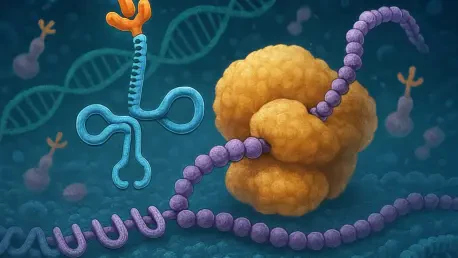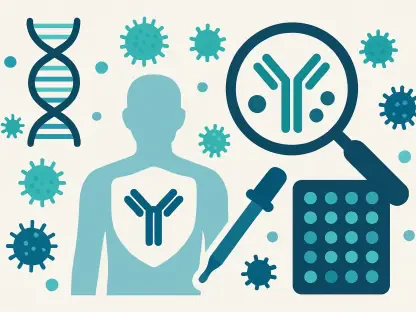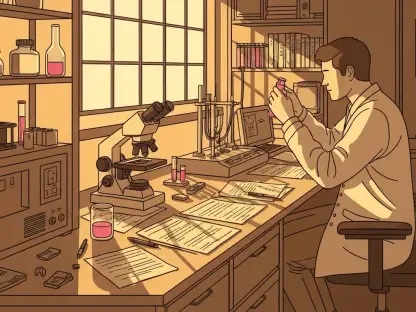In the rapidly advancing realm of synthetic biology, a remarkable innovation is capturing the attention of scientists and industry leaders alike: the potential to produce proteins outside the confines of living cells using synthetic transfer RNA (tRNA) arrays. This cutting-edge development, spearheaded by researchers from the University of Tokyo and the RIKEN Center for Biosystems Dynamics Research, could redefine the landscape of biotechnology. Published recently in Nature Communications, this work introduces a pioneering technique that synthesizes all 21 essential tRNA types in a cell-free environment, addressing a critical barrier in protein engineering. Imagine a system where the unpredictability of biological organisms is replaced by precise, controllable platforms capable of churning out life-saving drugs or industrial enzymes with unparalleled consistency. This vision is no longer a distant dream but a tangible possibility, sparking excitement about the future of protein production and its far-reaching implications for science and industry.
Unlocking the Power of tRNA in Synthetic Biology
The cornerstone of protein synthesis lies in transfer RNA, or tRNA, which serves as a vital molecular bridge decoding genetic instructions by pairing mRNA codons with specific amino acids during translation. Without a full set of at least 21 tRNA variants, the machinery of protein creation cannot function, as each amino acid relies on a corresponding tRNA to be incorporated into the growing protein chain. For years, producing these tRNAs individually in a lab setting has posed a formidable challenge due to their structural diversity and the intricate processing they require. This bottleneck has slowed the development of fully synthetic systems that could replicate or even surpass natural protein production, limiting the scope of bioengineering applications.
A groundbreaking solution, known as the tRNA array method, has emerged to tackle this longstanding issue head-on. By encoding the genetic templates for all 21 tRNAs onto a single DNA plasmid, researchers have enabled their simultaneous transcription within a specialized cell-free system devoid of native tRNAs. Enzymatic tools, such as the hepatitis delta virus (HDV) ribozyme and RNase P, play a crucial role in cleaving and maturing these tRNAs, ensuring their functionality without the need for tedious purification steps. This innovative approach dramatically boosts efficiency, sidestepping the labor-intensive process of handling each tRNA separately and setting a new standard for in vitro protein synthesis technology.
Transforming Industries with Cell-Free Protein Systems
The advent of the tRNA array method heralds a transformative era for protein production, offering systems that can operate independently of living cells with remarkable precision and adaptability. Unlike natural organisms, which are often susceptible to environmental fluctuations and biological inconsistencies, synthetic platforms can be meticulously engineered for stability and specific functionalities. This shift holds immense promise for industries like pharmaceuticals, where consistent quality and purity are non-negotiable. A cell-free system could streamline the production of complex drugs, slashing costs and accelerating development timelines by eliminating variables inherent in cellular environments, thus ensuring higher yields and safer outcomes.
Beyond medicine, the impact extends to industrial biotechnology, where tailored enzymes could revolutionize manufacturing processes. The modularity of synthetic systems allows for rapid customization of proteins to meet specific needs, potentially leading to more efficient catalysts that reduce waste and energy consumption in production lines. Additionally, the tRNA array method facilitates genetic code expansion, enabling the incorporation of non-standard amino acids into proteins. This capability opens the door to creating novel molecules with enhanced properties, such as improved binding for therapeutic applications or unique characteristics for advanced materials, pushing the boundaries of what proteins can achieve in practical settings.
Pioneering the Future of Molecular Machines
Looking toward the horizon, the tRNA array method fuels an ambitious vision of developing self-reproducing molecular machines that could mimic or even redefine life itself. Such systems would serve as controlled experimental platforms, offering unprecedented opportunities to explore the origins and evolution of biological processes outside the complexities of living organisms. By constructing synthetic cell-like environments with adjustable functions, scientists could simulate and study fundamental mechanisms of life, potentially uncovering insights into how molecular assemblies evolved into complex organisms over millennia. This research marks a critical step toward realizing such futuristic systems, bridging the gap between engineering and natural biology.
Equally compelling is the scientific value of studying protein synthesis in a fully reconstituted setup free from the unpredictable variables of living cells. In this controlled environment, specific components can be isolated and manipulated with precision, providing a clearer understanding of processes like translation accuracy and tRNA-amino acid pairing. These insights could answer long-standing questions about the genetic code’s evolution and fidelity, offering a unique perspective unattainable through traditional biological models. The ability to experiment in such a sandbox environment positions synthetic biology as a powerful tool for both practical innovation and the pursuit of fundamental knowledge.
Building Tomorrow’s Biotechnology Landscape
Reflecting on this monumental stride in synthetic biology, the development of the tRNA array method stands as a defining moment that addressed a critical hurdle in protein synthesis. Published on August 26, 2025, in Nature Communications, this research demonstrated the simultaneous production of all 21 tRNA types in vitro, setting a robust foundation for autonomous protein production systems. The efficiency gained through a single-plasmid design and precise enzymatic processing redefined what was possible in cell-free translation, proving that synthetic systems could rival or exceed natural processes in consistency and control.
Moving forward, the focus should shift to scaling these systems for widespread industrial adoption, ensuring they meet the rigorous demands of pharmaceutical and biotechnological applications. Investment in further research to integrate additional genetic elements could enhance the versatility of these platforms, while exploring self-reproducing molecular setups might unlock deeper scientific truths. Collaboration across disciplines will be essential to refine genetic code expansion techniques, creating proteins with novel functions for unmet medical and industrial needs. This breakthrough lays the groundwork for a future where synthetic biology drives innovation, offering solutions that reshape how society interacts with life’s core processes at a molecular level.









